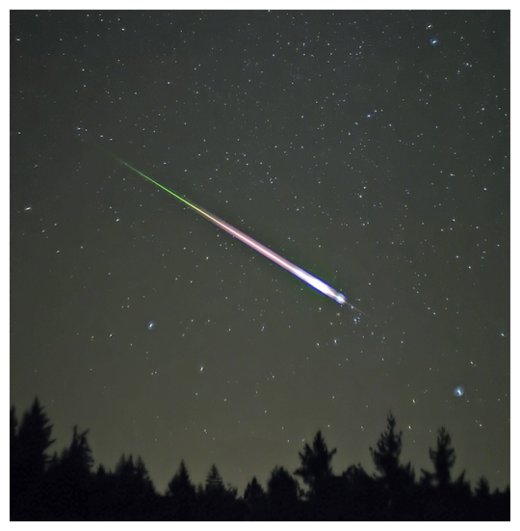
© Wikimedia CommonsA meteor during the peak of the 2009 Leonid Meteor Shower. The photograph shows the meteor, afterglow, and wake as distinct components.
Spearfish —
The mystery of what caused Monday's loud boom remains.Some theories have been refuted, while more mysterious references have appeared.
Shortly before 2 p.m., the boom was heard throughout the Black Hills. Some people said it shook their homes or businesses, rattling windows, and scaring them in several instances.
But the noise was heard in a much larger area than the Black Hills. Responses to Tuesday's Black Hills Pioneer story reported hearing the noise from Western Nebraska to Southeast Montana.
Kathy Griesse reported hearing the noise near the Agate Fossil Beds National Monument south of Harrison, Neb. She said it sounded like the noise came from the north and west of her. Additionally, she talked to people in Crawford, Neb., where people told her windows rattled at the sound of the boom; people in Whitney, Neb., also heard the noise.
On the northern end of reports, Lane Pilster said he heard the boom at his ranch, 14 miles west of Alzada, Mont.
This is about a 200-mile straight-line distance between the two reported locations.
Pilster reported that he and his dad both heard the noise to the south of them.
"The beginning of it was intense, but then faded off with a dull rumbling like a jet was flying by. The sound probably lasted about 8-10 seconds," Pilster said.
He also said he felt a moderate vibration around 5:30 a.m. Monday, and that it lasted 15-20 seconds.
He wasn't the only one to hear a strange noise apart from the 2 p.m. event.
Brad Scott, of Spearfish, heard a loud boom in downtown Spearfish around 7:30 a.m. Sunday
He described it as the "sound of about 8 shotguns going off at once."
So what was the noise?



Comment: The International Meteor Organization (IMO) has received over 80 reports about a fireball seen over England, County Mayo, Wales, Northern Ireland, Nord-Pas-de-Calais Picardie, Scotland, Gelderland, County Galway, Zeeland, Vlaanderen, County Kilkenny, Limburg and Wallonie on Wednesday, November 23rd 2016 around 17:20 UT.
NASA space data supports citizens' observations that - meteor fireball activity is increasing dramatically!